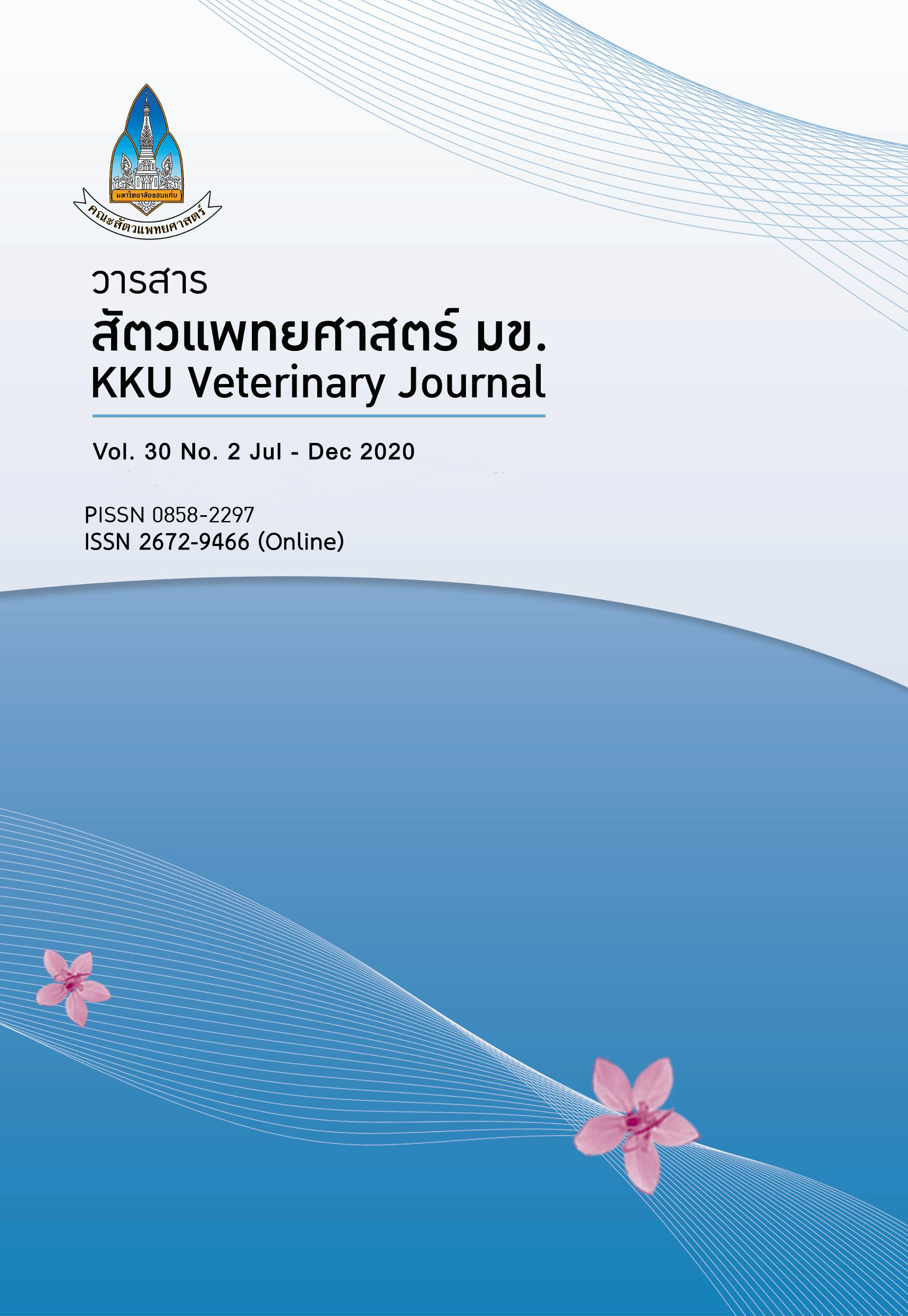การศึกษาฤทธิ์ต้านจุลชีพของสารสกัดจากใบสะเดา ในการยับยั้งเชื้อราและแบคทีเรียก่อโรค
Main Article Content
บทคัดย่อ
วัตถุประสงค์ เพื่อศึกษาฤทธิ์ในการต้านเชื้อแบคทีเรียก่อโรคในสัตว์และฤทธิ์ต้านเชื้อราของสารสกัดจากใบสะเดา รวมทั้งค่าความเข้มข้นต่ำสุดที่ยับยั้งเชื้อได้ของเชื้อแต่ละชนิด
วัสดุ อุปกรณ์ และ วิธีการ เก็บตัวอย่างจากสัตว์ป่วย และนำมาเพาะแยกชนิดของเชื้อแบคทีเรียก่อโรค จากนั้นสกัดใบสะเดาด้วยเอทานอล แล้วนำสารสกัดที่ได้มาทดสอบประสิทธิภาพในการยับยั้งเชื้อชนิดต่างๆ จำนวน 25 ตัวอย่างด้วยวิธี Broth microdilution method จากนั้นทำการทดสอบหาค่าความเข้มข้นต่ำสุดที่มีฤทธิ์ที่สามารถฆ่าเชื้อของสารสกัดสะเดา (MBC, MFC) โดยเชื้อที่ใช้ทดสอบได้แก่เชื้อแบคทีเรียแกรมบวก 4 ชนิด : Streptococcus spp., S. aureus, S. hyicus, Staphylococcus intermedius และเชื้อแบคทีเรียแกรมลบ 4 ชนิด : P. aeruginosa, A. hydrophila, E. coli, Klebsiella spp. โดยมีเชื้อ E. coli ATCC 25922, S. aureus ATCC 25923 และยาเจนตามัยซินเป็นเชื้อและยาควบคุมมาตรฐาน และเชื้อราที่ใช้ศึกษาคือ C. neoformans และ C. albicans โดยมีคีโตโคนาโซลเป็นยาควบคุมมาตรฐาน
ผลการศึกษา ผลการทดลองพบว่าสารสกัดจากใบสะเดามีฤทธิ์ในการต้านเชื้อแบคทีเรียและเชื้อรา โดยค่าความเข้มข้นต่ำสุดที่สามารถฆ่าเชื้อแบคทีเรีย (MBC) ของสารสกัดจากใบสะเดาต่อเชื้อ Streptococcus spp., S. aureus, S. hyicus, S. intermedius, P. aeruginosa, Aeromonas hydrophila, E. coli และ Klebsiella spp. มีค่าเท่ากับ 7.81-31.25, 31.25-62.5, 31.25, 500, 125, 500, 1000, 250-1000 มก. / มล. ตามลำดับ และผลการทดสอบหาค่าความเข้มข้นต่ำสุด (MFC) ต่อการฆ่าเชื้อราของสารสกัดจากใบสะเดาต่อเชื้อ C. neoformans และ C. albicans มีค่า 2000 และ 2000 มก. / มล. ตามลำดับ
ข้อสรุป สารสกัดจากใบสะเดาซึ่งสกัดด้วยเอทานอลมีฤทธิ์ในการยับยั้งการเจริญเติบโตและต่อต้านเชื้อแบคทีเรียหลายชนิดในการทดลองนี้ ซึ่งเป็นเชื้อแบคทีเรียที่ก่อโรคในสัตว์โดยมีค่า MBC ที่ต่างกัน และในการเปรียบเทียบด้วยฐานนิยม พบว่า ค่าความเข้มข้นต่ำสุดที่สามารถฆ่าเชื้อแบคทีเรีย (MBC) ของกลุ่มแบคทีเรียแกรมบวกมีค่าต่ำกว่ากลุ่มแบคทีเรียแกรมลบ นอกจากนี้พบว่าสารสกัดจากใบสะเดายังสามารถยับยั้งการเจริญของเชื้อยีสต์ได้แก่ C. neoformans และ C. albicans ได้อีกด้วย สะเดาจึงนับเป็นสมุนไพรที่น่าจะได้รับการศึกษาต่อยอด เพื่อนำมาใช้ประโยชน์ในทางการแพทย์และสัตวแพทย์ในอนาคต
Article Details
เอกสารอ้างอิง
Boonmar S, Markvichitr K, Chaunchom S, Chanda C, Bangtrakulnonth A, Pornrunangwong S, Yamamoto S, Suzuki D, Kozawa K, Kimura H, Morita Y. 2008. Salmonella prevalence in slaughtered buffaloes and pigs and antimicrobial susceptibility of isolates in Vientiane, Lao People’s Democratic Republic. J Vet Med Sci 70(12), 1345–1348.
Buttasri A, Chatchawanchonteera A, Papirom P, Kampanawarawan W. 2005. Study of antibacterial property of garlic extract against Aeromonas hydrophila isolated from fish. KKU Vet J 15(1), 1-5.
Chatchawanchonteera A, Trakranrungsie N, Ownthum R, Prapakorn L, Luangsie S. 2003. Garlic and onion: their inhibition effect on Candida albicans. KKU Vet J 13(2), 16-23.
Chatchawanchonteera A, Wangboonskul J, Trongwanishnam K, Buttasri A, Borisutpeth P, Sriyamat M, Nampakdee N, Laohawat W. 2008. Antimicrobial activity of guava leaf and garlic extracts against Aeromonas hydrophila and Streptococcus spp. isolated from infected fish. KKU Vet J 18, 46-53.
Elavarasu S, Abinaya P, Elanchezhiyan S, Thangakumaran VK, Naziya B. 2012. Evaluation of anti-plaque microbial activity of Azadirachta indica (neem oil) in vitro: A pilot study. J Pharm Bioallied Sci 4(Suppl 2), S394–396.
Ishrat I, Imran A, Muhammad A, Aqeel J, Neelma M, Rasheeda B. 2016. In vitro evaluation of antiviral activity of leaf extracts of Azadirachta indica, Moringa oleifera, and Morus alba against the foot and mouth disease virus on BHK-21 cell line. ScienceAsia 42, 392–396.
Jagadeesh K, Srinivas K, Shreenivas,PR. 2014. Anti inflammatory effect of Azadirachta Indica (Neem) in albino rats-an experimental study. IOSR J Pharm. 4(1), 34-38.
Jiwakanon J, Papirom P, Worarach A, Jiwakanon N. 2003. An assessment of antimicrobial efficacy of garlic extract constituents against selected pathogenic bacteria in poultry and pigs. KKU Vet J 13(2), 24-37.
Jantarasanit W, Angkititrakul S, Noimay P, Rattanaporn W. 2005. Effect of guajava Linn.leaf crude extract on inhibition of Salmonella enteritidis in native cross breed chicken. KKU Vet J 15(1), 41-46.
Kumar VS, Navaratnam V. 2013. Neem (Azadirachta indica): Prehistory to contemporary medicinal uses to humankind. Asian Pac J Trop Biomed 3(7), 505–514.
Maleki L, Sadeghian-Rizi T, Ghannadian M, Hossein Sanati M, Shafizadegan S, Sadeghi-Aliabadi6 H. 2018. Antibacterial activity of Azadirachta indica leaf extracts against some pathogenic standards and clinical bacterial isolates. Avicenna J Clin Microb Infec 5(1), e12987.
Mohammad A. 2016. Therapeutics role of Azadirachta indica (Neem) and their active constituents in diseases prevention and treatment. Evid Based Complementary Altern Med. p. 1-11.
Nuangmek A, Rojanasthien S, Chotinun S, Yamsakul P, Tadee P, Thamlikitkul V, Nattasit T, Patchanee P. 2018. Antimicrobial resistance in ESBL-producing Escherichia coli Isolated from layer and pig farms in Thailand. Acta Sci Vet 46, 1538.
National Committee for Clinical Laboratory Standards. 2000. Methods for dilution antimicrobial susceptibility test for bacteria that grow aerobically; Approved Standard- Fifth Edition. NCCLS document M7- A5 (ISBN 1-56238-394-9). NCCLS, 940 West Vally Road, Suite 1400, Wayne, Pennsylvania 19087- 1898, USA.
Noppon B, Sangmaneedet S, Chanlun S. 2005. Effect of galangal powder mixed diets on lesion scores of caecal coccidiosis In broilers. KKU Vet J 15(1), 41-46.
Parida M, Upadhyay C, Pandya G, Jana M. 2002. Inhibitory potential of neem (Azadirachta indica Juss) leaves on Dengue virus type-2 replication. J Ethnopharmacol 79, 273-278.
Preeti M, Mehta K, Manisha T, Shakkarpude J, Jain, 2015. A Evaluation efficacy of herbal preparations for the treatment of canine mange. Sch J Agric Vet Sci 2(4), 282-284.
Quinn PJ, Carter ME, Markey BK, Carter GR. 1994. Clinical Veterinary Microbiology. Wolfe Publishing. Spain. 648p.
Sara JB, Marelle GB, Gerrit MA, Joop VL. Arnold VH, Marcel D. 2004. Safety evaluation of neem (Azadirachta indica) derived pesticides. J Ethnopharmacol 94(1), 25–41.
Shrivastava DK, Kshma S. 2014. Antifungal activity of leaf extract of neem (Azadirachta Indica Linn.) Int J Curr Microbiol App Sci 3(5), 305-308.
Soikum C, Leungtongkum P, Rattanaporn W. 2005. The study of Stemona Tuberosa extracts for control the fly larvae. KKU Vet J 15(1), 47-53.
Zhang YQ, Xu J, Yin ZQ, Jia RY, Lu Y, Yang F. 2010. Isolation and identification of the antibacterial active compound from petroleum ether extract of neem oil. Fitoterapia 81(7), 747–750.
Zhong P, Yu Q, Zhong Y, Jiao X, Ren Y, Yang L. 2010. Antibacterial activity of 9-octadecanoic acid-hexadecanoic acid-tetrahydrofuran-3,4-diyl ester from neem oil. Agr Sci China 9(8), 1236–1240.


